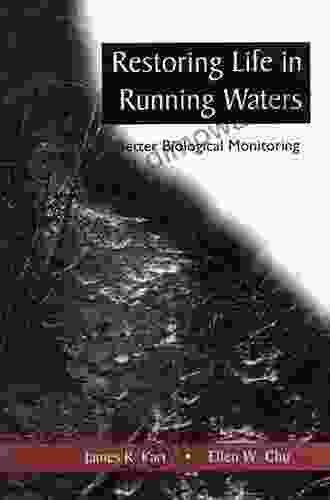Restoring Life in Running Waters: Better Biological Monitoring for Cleaner, Healthier Rivers

Rivers are the lifeblood of our planet, providing essential water, food, and habitat for countless species. However, human activities have taken a toll on our waterways, leading to pollution, habitat loss, and degradation. Biological monitoring is a critical tool for assessing the health of our rivers and developing effective restoration strategies.
5 out of 5
| Language | : | English |
| File size | : | 347 KB |
| Text-to-Speech | : | Enabled |
| Screen Reader | : | Supported |
| Enhanced typesetting | : | Enabled |
| Print length | : | 112 pages |
| Lending | : | Enabled |
The Importance of Biological Monitoring
Biological monitoring involves the study of living organisms in a river to assess its overall health. By examining the diversity, abundance, and health of aquatic life, scientists can gain valuable insights into the river's water quality, habitat conditions, and overall ecological integrity.
Biological monitoring provides several key advantages over traditional chemical and physical monitoring methods:
- Integrates multiple factors: Biological monitoring takes into account the cumulative effects of multiple stressors on the river ecosystem, providing a more comprehensive assessment of water quality.
- Reflects long-term impacts: Many aquatic organisms have long life cycles, integrating the effects of past and present pollution events, providing a more accurate picture of river health over time.
- Early warning system: Biological monitoring can detect subtle changes in river health before they become visible through chemical or physical measurements, allowing for early intervention and mitigation efforts.
Best Practices for Biological Monitoring
Effective biological monitoring requires careful planning and implementation. Key best practices include:
- Selecting appropriate indicators: Different aquatic organisms respond to pollution and habitat degradation in unique ways, so selecting the right indicators is crucial. Common indicators include macroinvertebrates, fish, algae, and riparian vegetation.
- Standardized sampling methods: Consistent sampling methods ensure reliable and comparable data over time and across different locations.
- Data analysis and interpretation: Sophisticated statistical techniques are used to analyze biological data, identify patterns and trends, and assess the ecological significance of observed changes.
Using Biological Monitoring to Restore Rivers
Biological monitoring plays a vital role in the restoration of degraded rivers. By identifying the stressors affecting river health, stakeholders can develop and implement targeted restoration strategies:
- Reducing pollution: Identifying and addressing sources of pollution, such as agricultural runoff, industrial wastewater, or sewage discharge, is essential for restoring water quality.
- Improving habitat: Restoring riparian vegetation, creating instream structures, and removing barriers to fish passage can enhance habitat quality and support aquatic life.
- Community engagement: Involving local communities in monitoring efforts fosters a sense of ownership, encourages stewardship, and ensures the sustainability of restoration efforts.
Recent Advances in Biological Monitoring
Technological advancements have revolutionized biological monitoring in recent years:
- DNA barcoding: DNA-based identification techniques allow for more accurate and rapid identification of aquatic species, even in complex ecosystems.
- Remote sensing: Satellite imagery and aerial photography can be used to map riparian vegetation, identify potential pollution sources, and monitor long-term riverine changes.
- Citizen science: Engaging citizen scientists in monitoring efforts can expand data collection, increase public awareness, and foster a sense of community stewardship.
Biological monitoring is an indispensable tool for restoring the health of our running waters. By providing a comprehensive assessment of river ecosystems, biological monitoring helps us identify stressors, develop effective restoration strategies, and ensure the long-term health and sustainability of our rivers. Protecting and restoring our rivers is not just about preserving nature, but about safeguarding the well-being of our communities and future generations.
Join the movement to restore life in running waters and ensure a cleaner, healthier future for all.
5 out of 5
| Language | : | English |
| File size | : | 347 KB |
| Text-to-Speech | : | Enabled |
| Screen Reader | : | Supported |
| Enhanced typesetting | : | Enabled |
| Print length | : | 112 pages |
| Lending | : | Enabled |
Do you want to contribute by writing guest posts on this blog?
Please contact us and send us a resume of previous articles that you have written.
 Book
Book Novel
Novel Page
Page Chapter
Chapter Text
Text Story
Story Genre
Genre Reader
Reader Library
Library Paperback
Paperback E-book
E-book Magazine
Magazine Newspaper
Newspaper Paragraph
Paragraph Sentence
Sentence Bookmark
Bookmark Shelf
Shelf Glossary
Glossary Bibliography
Bibliography Foreword
Foreword Preface
Preface Synopsis
Synopsis Annotation
Annotation Footnote
Footnote Manuscript
Manuscript Scroll
Scroll Codex
Codex Tome
Tome Bestseller
Bestseller Classics
Classics Library card
Library card Narrative
Narrative Biography
Biography Autobiography
Autobiography Memoir
Memoir Reference
Reference Encyclopedia
Encyclopedia Felicja Nowak
Felicja Nowak Fritz Nordengren
Fritz Nordengren Fred Benham
Fred Benham Kirsten Mccay Smith
Kirsten Mccay Smith T D Ramatlho
T D Ramatlho Fredrik Borjesson
Fredrik Borjesson George Baird
George Baird Terry Deary
Terry Deary Eunice Lipton
Eunice Lipton Fabio Casciati
Fabio Casciati Steve Wisecarver
Steve Wisecarver Falk Holzapfel
Falk Holzapfel Malcolm Cook
Malcolm Cook Floyd Jay Winters
Floyd Jay Winters Federico Marcon
Federico Marcon Frances Gendlin
Frances Gendlin Tom Bruce
Tom Bruce Thomas O Shea
Thomas O Shea Michelle Mullen
Michelle Mullen Tsuyoshi Miyazaki
Tsuyoshi Miyazaki
Light bulbAdvertise smarter! Our strategic ad space ensures maximum exposure. Reserve your spot today!

 Ernest J. GainesThe Knowledge of Nature and the Nature of Knowledge in Early Modern Japan
Ernest J. GainesThe Knowledge of Nature and the Nature of Knowledge in Early Modern Japan
 Walt WhitmanKingdom of Rebels and Thorns: The Aermian Feuds – A Literary Masterpiece that...
Walt WhitmanKingdom of Rebels and Thorns: The Aermian Feuds – A Literary Masterpiece that...
 Drew BellTop 30 Family Activities in New York City: Unforgettable Memories and Endless...
Drew BellTop 30 Family Activities in New York City: Unforgettable Memories and Endless... Robert Louis StevensonFollow ·14.2k
Robert Louis StevensonFollow ·14.2k Walt WhitmanFollow ·8.7k
Walt WhitmanFollow ·8.7k John SteinbeckFollow ·14.9k
John SteinbeckFollow ·14.9k Mark TwainFollow ·3.8k
Mark TwainFollow ·3.8k Wesley ReedFollow ·3.8k
Wesley ReedFollow ·3.8k Ryūnosuke AkutagawaFollow ·2.3k
Ryūnosuke AkutagawaFollow ·2.3k Rubén DaríoFollow ·19.5k
Rubén DaríoFollow ·19.5k Barry BryantFollow ·13.9k
Barry BryantFollow ·13.9k

 Braden Ward
Braden WardYounger Ten: Writing the Ten-Minute Play
Unlock the Secrets of...

 Jon Reed
Jon ReedAffiliate Marketing Super Affiliate Marketing: The...
Are you ready to unlock the...

 Yukio Mishima
Yukio MishimaMaster the Fundamentals of Quality Improvement with "The...
Unlock Your...

 Nathan Reed
Nathan ReedCamping Around Victoria High Country: Explore Australia's...
Prepare to be captivated by the...
5 out of 5
| Language | : | English |
| File size | : | 347 KB |
| Text-to-Speech | : | Enabled |
| Screen Reader | : | Supported |
| Enhanced typesetting | : | Enabled |
| Print length | : | 112 pages |
| Lending | : | Enabled |










